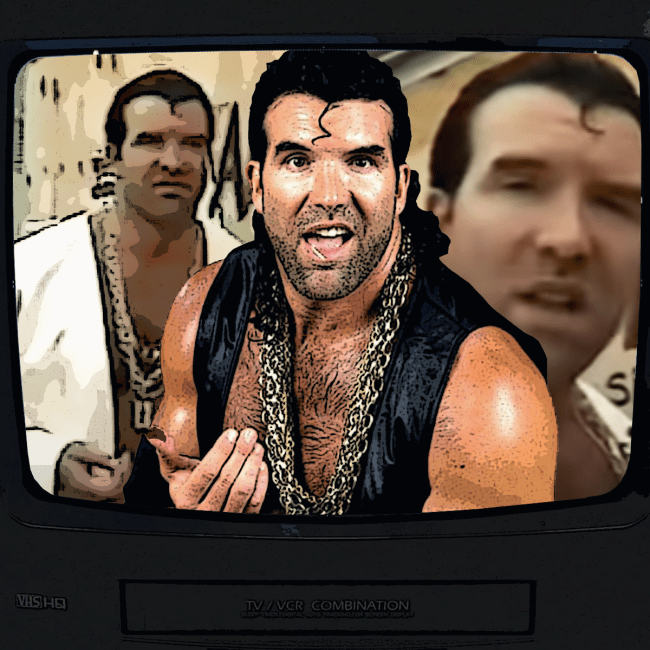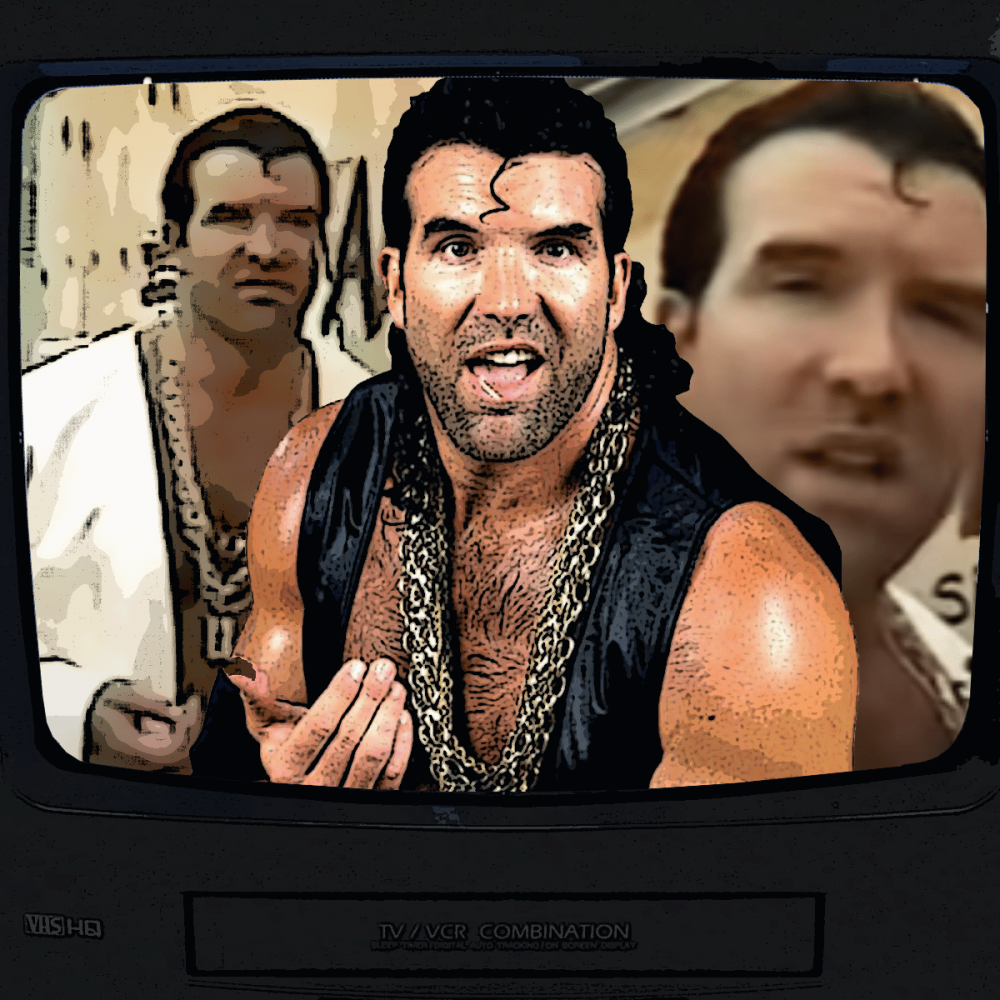
Photo via Scott Hall/Instagram/YouTube
Evan McGarvey‘s three-year-old calls his dinosaur figurine “Sir Drips-a-Lot” so now you can look for the Givenchy x Nacho McGarvey collaboration come 2024.
The story is apocryphal, as all meaningful wrestling stories are.
It’s 1992. Scott Hall is roughly a decade into his wrestling career. Big, raw-boned and handsome, Hall has survived aging companies and execrable gimmicks — an imitation Hulk Hogan instructed to use Hogan’s old move set; a gator-chasing country boy; an imitation Rick Rude with a diamond earring.
Now he faces the first truly promising break of his career.
He’s in a conference room in Connecticut. He meets with an audience of two. The first is the boss: Vince McMahon, the relentless, antagonistic Walt Disney-plus-Ronald-Reagan of wrestling. Second: Pat Patterson, superb ’60 and ’70s wrestler turned McMahon’s brain, architect not only of consummate matches and feuds but also of the concepts (Royal Rumble, et al) that made the then-WWF’s brand of wrestling into the industry standard.
We’re in the WWF’s occupation era. A plumber-wrestler. A dentist-wrestler. You get the idea. In the meeting, McMahon suggests that Hall become a soldier-wrestler, as Hall himself was an Army brat, never living in one place for more than a year throughout his childhood.
As the legend goes, Hall replies something like: “If you want me to be a soldier, I’ll be the best soldier I can be. But what about if you, ‘say hello to the bad guy!’” Hall then strikes that pose that a generation of wrestling fans will come to recognize: hips out, arms out, pouting, a naked homage to Scarface that somehow wasn’t parody.
Hall continues to explain his character with the full Gospel of Tony Montana playbook: The animal prints. The toothpick. The methodical, achingly calm walk to the ring. The very cheesy Miami-Dade Cuban accent. This is Razor Ramon. This is the birth of the cool.
The space between ideas in pro wrestling and their execution depends on audience expectation. How the wrestler uses that space, that leap-of-faith, is both how they work—their moves and deportment in the ring — and how they ‘work,’ how they use pathos and exaggeration on their co-workers backstage.
Neither Patterson nor McMahon had seen Scarface. What they saw from Hall in that conference room must have been like those old pictures of the Pentecost where small flames of truth plummet into the heads of the Apostles. McMahon and Patterson were apparently in raptures, Patterson apparently muttering “Genius! This guy is a genius!” over and over.
In that conference room by I-95 in Connecticut, Scott Hall didn’t just seize his career breakthrough, he worked the decision makers at the highest level. Patterson and McMahon got worked. Scott Hall could work anyone.
It’s challenging to define the moment when the big Manichean primary colors of 80s wrestling became the smeary, ambiguous, mesmerizing New-Generation-into-Attitude-Era epoch. There are a few signal moments.
I’d argue that those first Razor Ramon vignettes would make a fine choice. Like most good art, their vision was clear and their emotions were complicated. This guy in guayabera shirts and Hawaiian shirts stalking around a fruit stand, cruising in a cherry red Biarritz, reciting lines from Scarface verbatim, who is he? Good guy? Bad guy? Here was someone vividly human, a character worthy of imitation. Show me an American bro of any gender and background who didn’t flick a toothpick in the ‘90s and I’ll show you a gray, gray life.
The twist was that Razor’s in-ring genius ultimately came from losing. He transferred his machismo to others. Shawn Michaels went from pouty, bejeweled pretty boy to warrior after fighting Razor Ramon with ladders. Sean Waltman became an exemplary undersized scrapper when Razor lost to him on Monday Night Raw. As David Shoemaker wrote, in a world of Hulk Hogan and other megastars, Hall was the kind of character who had to lose. But Hall made beating him consequential.
Beyond the matches, Hall appeared in some of the most important individual camera shots of his era. He’s standing on one of the turnbuckles during the Curtain Call. He was the first of the NWO troika to appear on WCW television, dropping the Razor gimmick and instead becoming, well, Scott Hall. Even his costume changes during those early days of the NWO telegraphed energy. Hall’s clothes went from Razor Ramon’s purple and gold trunks to ‘most handsome guy at a motorcycle festival’ — no man has worn a Canadian Tuxedo better—to chatty nihilist in NWO black. Hall ended Goldberg’s streak with a jab of a Taser. Hall gave Sting the idea for Sting’s “Crow” gimmick.
That skill for finding the elusive seams of wrestling was another of Hall’s gifts. After his in-ring career ended, he became a font of wisdom — for a price. Through a dozen shoot interviews in the 2000’s and on, Hall unfurled stories and anecdotes and cold hard facts about wrestling in confessional-style one-camera dialogues. These interviews were filmed in crummy hotels by airports with the plastic sign of whichever wrestling tape company was paying affixed to the wall behind Hall. The interlocutor—a mark like you, maybe—would ask bland questions. And Scott Hall spun his answers into gold.
In my 20s, I had a late-night job fact checking at a tabloid. I checked the correct spellings of restaurants and movie release dates from noon to 2AM, three days a week. Though the office was in a grand old building in Manhattan, the work was mostly alone. I would watch the Scott Hall shoot interviews in hour-long loops, Hall’s voice piped into my headphones as I went over page proofs. It was 2008 and the ragged, copyright-defying edges of YouTube had not yet been sanded off.
Hall talked about lightly stalking Barry Windham in a Florida grocery store as he tried to break into the business. He told stories about Nick Bockwinkel delivering kind, detailed answers to Hall’s novice questions in the locker room, Bockwinkel lecturing naked from the waist down. Hall told a story about inventing the Razor Ramon character with not-yet — Mr. Perfect Curt Hennig as they drove through snowstorms in the Upper Midwest.
I heard stories from Hall and Kevin Nash driving into Canada for Wrestlemania 18, about them bribing a border patrol guard with signed posters and a Horn ‘O’ Plenty of gear, reducing the guard to a giddy child. I listened to this and knew in my soul that I’d be that border guard too, letting two guys I thought were deeply cool in middle and high school slide into the country without a look at their passports. In those interviews, Hall offered compelling, pungent Denis Johnson and Hunter S. Thompson-esque alternative histories of pro wrestling that flew in the face of ‘official’ WWE-codified ones.
It’s impossible to write about Hall and history without mentioning Hall’s own history. Hall was involved in a fight outside a bar in the early 1980s. A man was pulling a gun on Hall and as Hall wrestled with him for the gun, it went off, killing the other man. All eventual criminal charges were dropped. Hall told ESPN during a 2011 interview that he had never stopped going over that night in this head. So, like billions of people on earth, he drank to mask his pain. And even in the substance-soaked world of pro wrestling, Hall’s drinking became famous. It feels oily to go into detail about the incidents. He got into scuffles everywhere with everyone. He was arrested and arrested again and fired and, in one of the grosser moments in pro wrestling, had his alcohol abuse stitched into his character’s gimmick during the last days of WCW.
I remember a shoot interview where Hall talked about how the rehabs he tried initially were from the ‘practical,’ checklist-style school (Get a hobby! Don’t work in the hospitality industry! Have sober friends!) and he didn’t make progress until he got in front of actual Ph.D’s and M.D. who helped him understand who the trauma of having shot a man likely stood at the core of his addiction. I wonder how many people with addictions saw that interview and understood that they needed a different kind of help.
Hall’s addiction wasn’t a dull cautionary tale. There wasn’t a car crash element to Hall’s pain; there was recognition. We knew people like this. We loved them: the cousin who got incandescently drunk before her sibling’s baby shower and vomited on the new crib; the teacher who should have retired a decade ago stumbling on the stairs of your middle school; the friend who was in Peace Corps telling us about a fellow volunteer trying desperately to find alcohol on an island where all the stores are closed on Sunday; you, maybe, who lost at least two years and alienated once close friends by the handful.
Hall’s addiction reminds us that addiction runs parallel to a life. It doesn’t take it over. It never disappears because no real part of us ever really vanishes. “We are all old-timers, / each of us holds a locked razor,” the poet Robert Lowell wrote. The genuine emoting that Hall’s friends and colleagues — Shawn Michaels, Kevin Nash, Bret Hart — have shared since Hall’s death last week reminds us that even the people who love us don’t get the full story. People, like wrestlers, have to work themselves into life. We first convince ourselves of who we might be before we take those beliefs public. For all his sins and imperfections and human frailty, Scott Hall reminded wrestling fans that these confrontations with the self are never fully seen. We only get glimpses of the work that it takes to live.
The secret sauce in a half dozen of the most important moments in the past 35 years of wrestling . #RIPScottHall pic.twitter.com/KjqVV6CsWG
— Evan McGarvey (@evanmcgarvey) March 15, 2022

